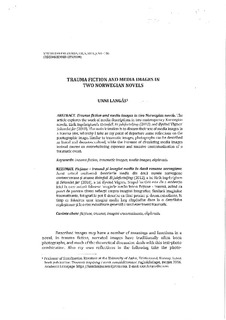| dc.contributor.author | Langås, Unni | |
| dc.date.accessioned | 2017-01-04T12:53:00Z | |
| dc.date.available | 2017-01-04T12:53:00Z | |
| dc.date.created | 2016-12-13T08:38:39Z | |
| dc.date.issued | 2016 | |
| dc.identifier.citation | Studia Universitas Babes Bolyai. Philologia. 2016, (LXI), 93-106. | |
| dc.identifier.issn | 1220-0484 | |
| dc.identifier.uri | http://hdl.handle.net/11250/2426295 | |
| dc.description.abstract | Described images may have a number of meanings and functions in a novel. In trauma fiction, narrated images have traditionally often been photographs, and much of the theoretical discussion deals with this text-photo combination. Also my own reflections in the following take the photo-describing narrative as their point of departure, but developments in media and communication technology have changed the situation thereby allowing new and different questions to be addressed. In this article, I will start out with a brief presentation of some approaches to trauma and photography, before I make concentrated analyses of two Norwegian novels, which incorporate descriptions of media images in their trauma plot: Eirik Ingebrigtsen’s Heimfall. Ei juleforteljing (2012) and Øyvind Vågnes’ Sekundet før (2010). The analyses will emphasize the basic function of images in trauma fiction, but they will also show how effects and implications of image description have changed due to new media formats and channels. | |
| dc.language.iso | eng | |
| dc.title | Trauma fiction and media images in two Norwegian novels. | |
| dc.type | Journal article | |
| dc.type | Peer reviewed | |
| dc.source.pagenumber | 93-106 | |
| dc.source.journal | Studia Universitas Babes Bolyai. Philologia | |
| dc.source.issue | LXI | |
| dc.identifier.cristin | 1411805 | |
| cristin.unitcode | 201,14,2,0 | |
| cristin.unitname | Institutt for nordisk og mediefag | |
| cristin.ispublished | true | |
| cristin.fulltext | original | |
| cristin.qualitycode | 0 | |
